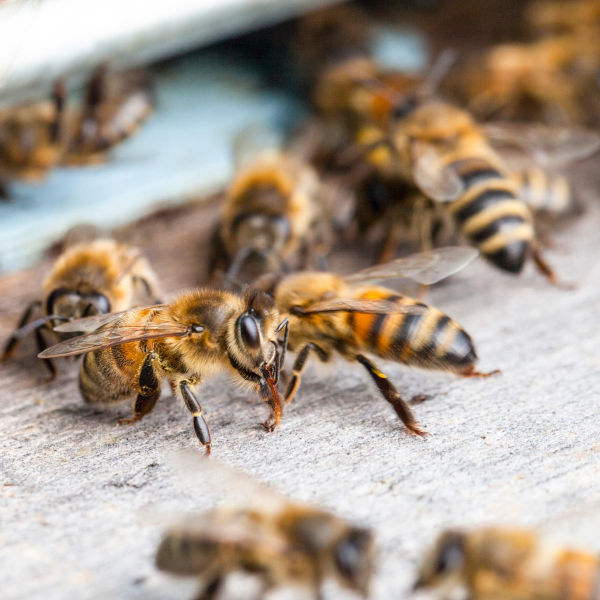 While Yuma farmers rave over the benefits of pollinating bees as pollinators, everyone else is busy side-stepping them so as not to get stung!
While Yuma farmers rave over the benefits of pollinating bees as pollinators, everyone else is busy side-stepping them so as not to get stung!
Most of the time, we don’t even know if they are bees, wasps, or hornets. Yes, there are distinct differences among these three stinging pests! In fact, they vary in physical appearance, behavior, and sting potency.
Let’s go over the ways that bees, wasps and hornets can impact your health and property!
Stinging insects make appearances during warmer months, just in time for your backyard pool party. Figures. Here’s how to tell the difference between bees, wasps, and hornets.
There are about 30,000 bee species in the world. Bumble bees, carpenter bees, and honey bees are three types of bees that are most often found throughout the Southwest. The bumble bee has a rounded, fuzzy body that’s colored black and yellow.
Bumble bees spend their days buzzing from flower to flower gathering nectar and carrying pollen. Don’t let their cute, furry appearance fool you. If you disturb them or their nests, they will sting you.
Carpenter bees look similar to bumble bees. They are black and yellow in appearance, but the lower half of their bodies are fuzz free.
Only female carpenter bees can sting, but they rarely do. Instead of chasing you around the yard, carpenter bees spend most of their time doing damage to wood structures such as siding, fencing, and fascia boards.
Here in Yuma, you’ll most likely find honey bees tapping water sources near your home. They’ll drink from your pool, but also from the fresh water drainage from your AC unit.
Bands of dark yellow and brown color their bodies, and their hair looks less furry than the hair of bumble bees. Honey bees pollinate plants and have a huge incentive not to sting you unless they feel threatened. A honey bee’s stinger allows it to only sting once, and then it dies.
Wasps have cinched waists, and bands of yellow and black cover their bodies. They don’t have a furry look, so there’s no chance that you’ll mistake them as friendly. Wasps are somewhat aggressive. They can sting multiple times when they feel threatened or if you’re in their way.
While some wasps feed on flower nectar, others are meat eaters and aren’t much interested in pollinating your garden.
They are attracted to the hamburgers and hotdogs at your backyard barbecue. When they come calling, you’ll give a second thought to adopting that vegetarian lifestyle your quirky cousin told you about!
Tarantula hawk wasps are one of the most unusual types of wasps found in Yuma. These wasps inflict stings that are considered to be the most painful of any insect in the country. This sustainable-minded wasp attacks tarantulas, drags them back to its lair, and uses their carcasses for food and a nesting place for its babies.
Hornets are a type of wasp. They look similar to other types of wasps, but they are sometimes a little larger in size. They inherit the same aggressive nature of wasps, and often earn nicknames such as “murder hornet.” The European hornet is the only true hornet species that you’ll see swarming around Arizona.
The habitats of bees, wasps, and hornets vary by type. Bumble bees are found living in rodent holes, and they often die during winter.
Carpenter bees find housing in decayed wood structures or dying trees. Honey bees prefer hollow trees for their living quarters. Wasps set up house in gutters, eaves, and bushes; some types of wasps live underground.
Hornets like to build their nests high up to avoid disturbances. They take up residence in rooftop ac units, sheds, and dense tree limbs.
Given that the homes in Yuma don’t have gutters or aluminum siding, Hitman experts weighed in on where they frequently find hives.
“Bees, hornets and wasps can build hives just about anywhere in Yuma but they prefer the protection of bushes and vines.”
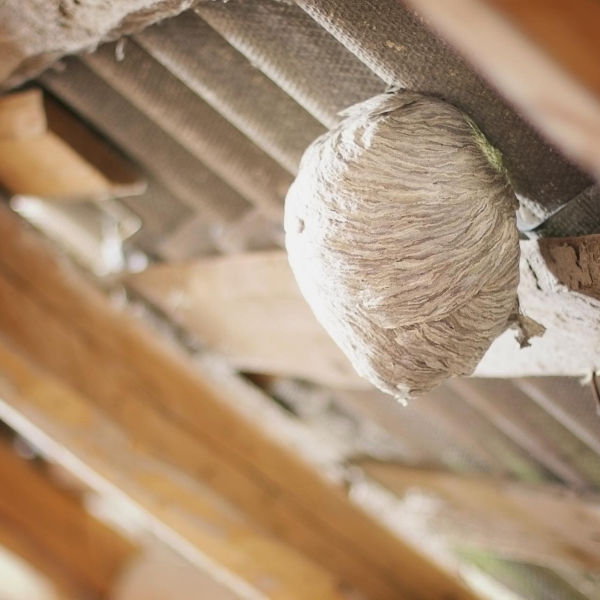
Have you spotted bees swarming around your home? You could have a beehive tucked underneath your wooden patio or roof overhang. Don’t zip up your bee suit or honey-collecting gear just yet.
The bees that are likely squatting on your property are carpenter bees or hornets. When left unchecked, carpenter bees cause extensive structural damage that costs home and business owners thousands of dollars in repairs.
Leaving a nest of hornets on your property is a health and safety risk. Hornets sting repeatedly with little provocation, and their stings are very painful.
The venom from bee, wasp, and hornet stings can cause deadly allergic reactions in sensitive individuals. When it comes to removing these pests, it’s best to call the professional exterminators to take care of your stinging insect problem.
Hitman Pest is committed to making Yuma homes and businesses safer and more enjoyable with effective pest control. We use proven pest management methods that eliminate infestations and prevent them from returning. If your property has a bee, wasp, or hornet problem, fight back by hiring a Hitman!
We have all seen the stories about “murder hornets” as we scroll through our social media feeds. The New York Times has reported the Vespa mandarinia, known as murder hornets, kill approximately 50 people every year in Japan and have made their way to the United States. Find out more about Murder Hornets and what people are doing to keep these pests under control.

Asian Giant Hornet by t-mizo
These hornets are approximately 2 inches long and have an orange-yellow head. They are reported to be very big and very beautiful. They are also very scary and seeing the arrival of this gigantic hornet is not a welcome sight.
The main risk of an invasion of murder hornets is the fear they will decimate Yuma’s local bee population, particularly the honeybee. The Vespa mandarinia is nicknamed the “murder hornet” because it snaps the head off of honeybees and other prey.
The murder hornet feeds on the bee larva. It doesn’t like the venomous flavor of worker honeybees. They don’t have a taste for the honeybee, but they find the young bees and the bee larva very appetizing. To obtain this larva, the murder hornet uses it huge mandibles to snap the head off the honeybees.
One murder hornet can kill approximately 4 honeybees each minute. If a swarm of murder hornets invade a bee colony, they can kill out the entire colony in only a few hours. Then they take the honeybee larva back to their hornet colony.
These hornets are invading Yuma, Arizona. However, experts agree that it is unlikely they will settle in the area. These hornets need moisture and will most likely settle in the coastal areas. Still yet, they can easily survive in the mountainous areas of Northern Arizona.
Vespa mandarinia which translates to Mandarian hornet does not sound as scary as “murder hornet”, but it is the largest stinging insect in the world. The murder hornet can produce a venom strong enough to kill humans. It can take less than a dozen stings to cause complete kidney failure.
Experts feel we will be able to keep the murder hornets from gaining a strong foothold and control them in Yuma and across the country. Murder hornets have an unusually low reproduction rate, which adds an advantage to exterminating them. Setting traps to capture the queen will eliminate any threat of a colony.
The invasion of these hornets could be trouble for the honeybees in Yuma. Three new specimens of these hornets have been discovered throughout the Pacific Northwest areas in 2020. Biologists have tried to eliminate the hornets last year, but have discovered they survived through the winter months and are mating as early as May.
These large stinging insects have been found in the area. Murder hornets are different from Yuma’s native bees. The murder hornet needs meat to provide for their young. The honeybee feeds off of pollen from plants. The murder hornet can also sting its victim over and over, while the honeybee loses its stinger and dies after the first sting.
Even if these hornets get established in Yuma, Arizona experts do not feel residence will need to stay inside to survive an invasion. They are fierce, but they are also scarce. The murder hornet thrives in a forested area, it feeds on sap from oak trees and prefers to nest underground. They are most often found in areas with high altitude and do not cohabit near people in residential areas.

Asian Giant Hornet 2 by Justin
The giant Asian hornets have a powerful sting with a very strong venom. They can deliver more than seven times the venom than a native Yuma honeybee. Less than a dozen of these stings can cause death to a human, and one single sting can kill a small animal. One sting form these gigantic hornets is estimated to be equivalent to about 10 yellow jacket stings.
The most recent hornet-ID reports list over 20 species of murder hornets. They are all very large but vary slightly in appearance. Some are striped and others are blotched. They have color patterns ranging from brown and gold to bluish-black. These hornets are very different from the native wasps and hornets in Yuma, Arizona.
Murder hornets raid beehives decapitating the bees. However, honeybees do fight back by surrounding their nest and waiting for the intruder. Once the murder hornet enters their area, they surround it and beat their wings repeatedly to raise the temperature and produce enough carbon dioxide to kill the hornet.
They have a stinger that is long enough to penetrate through several layers of clothes. While the honeybees venom is more powerful than that of the murder hornet, the murder hornet can deliver more than 10 times the venom than honeybees.
The danger or the murder hornet sting is not relative to the pain of its sting. With a stinger long enough to penetrate several layers of clothing, the pain from a fully penetrated murder hornet sting is ground dropping. Those who have fallen victim to these horrendous stings have described it as excruciating.
Pain aside, the danger of the murder hornet sting is not as severe to those not suffering from bee sting allergies. The murder hornet can sting repeatedly, but those who suffer less than 50 stings and do not have allergies to bee stings have a good chance of survival.
The danger to people is fairly low, officials are mainly concerned for the local honeybee population. Sightings of these giant murder hornets have prompted fear of these vicious insects establishing in Yuma, Arizona and devastating the bee population. While they completely ignore the honeybees honey, they seek the thorax to feed their young. Without the honeybee pollinating our food and the food we feed our livestock humanity will be greatly effected.
Termites are among the most destructive pests in the world and you need to call a termite control expert immediately if you think you have termites.
They are capable of creating havoc on several properties within no time. They can destroy properties worth thousands of dollars, thus creating instability on your properties.
Several factors may contribute to termites emerging. They include rising moisture levels, atmospheric pressure temperatures, wind, and light intensity. Even though several areas of the country may get termite swarms during the spring, in the region whereby temperatures are favorable, they may also flock in the fall.
Despite where you reside, it is good to keep termites keep out of your property. If you don't know what to look for, you might not be able to identify an invasion until it is too late.
This article gives an insight into several ways that can help you know that termites have invaded you. Therefore, you will become aware and take the necessary measure to eliminate them and avoid any further destruction.

Flying termites by Derek Keats is licensed under CC BY 2.0
This is a good indication that sooner or later that you may be infested with termites. This is the primary sign that termite infestation is on the way. Flying termites are also referred to as swarmers or alates.
Both females and males fly together as they search for a good site that they can establish a colony. This also depends on the termite species, since some may fly during the night while others fly during the daytime.
Others, such as dry wood termites, may tend to be active just after the rainy season. In case you detect them around your location; it is good to start looking for them both inside and outside your house, or any other places such as crevices where they tend to settle.
If you sit down in a cool place in silence and hear some clicking noise that is coming out of the walls, it can be a clear indicator that you have been infested by termites. This noise is produced by worker termites.
Head banging is used as a way of communication to cause an alarm or warn the others that they are invaded by a stranger and hence, should run for their lives.
Termites also make such noises whenever they are eating, and you can be able to hear them whenever you lean your ear on the wall. In addition, research was once done, and it showed that when they are exposed to music, they eat twice as much as those that did not have the music.
When a female and male termite gets a mate as well as a suitable site, they can start a colony, and they will shed their wings. They choose a specific spot, crawl toward it, and secure it. Afterward, they start mating so that they can start a new colony. These two became the king and the queen of that colony.
They take care of the young colony until the workers are mature and take this responsibility. Thereafter they transfer these responsibilities they take over again as the king and queen of that colony. They enlarge it and can live more than a decade

The species of drywood termite typically consume wood, thus leaving a thin layer of timber or paint. Whenever you tap or knock an area that has termite infestation or damage.
It will sound papery or hollow. The hollowness is because a part or all the timber inside has been consumed away. This is a significant sign of termite invasion
Several people confuse termites for white ants since they look similar and especially when they lose their wings. Termites have a lighter color, and their antennas are straight, while those of ants are bent. Termites also produce thicker waste matter than ants. Termite's wings are of the same size, while ants have one pair of wings that's larger than the other.
Window and doors that are tightly fitted tend to stick or gets hard to open. This is because of the presence of wet weather or humidity that makes them swell. This swelling can result due to termite infestation.
This is due to the fact that termites also produce moisture when they consume wood, and hence, the piece of wood gets damaged and warps. This may cause the doors and windows to get sticky. If you see this or other signs of termites, it's time to get residential pest management working immediately.
Tunnels are also referred to as galleries. They are apparently difficult to notice from outside. However, if you spot them on a piece of timber near your home, termites have certainly invaded your home
Dry wood termites never use their waste products when constructing their nest but instead push them toward the entrance of their nest; this is a major determinant that you should look for when you are examining any sign of termite invasion. You can see powdery, small black marks that can be visible along the walls, cracks corners, or vents of your house. If you see these, it means that you are near the entrance.
Subterranean termites build mud tubes to travel to their source of food that may be from your house. These thin tunnels preserve some moisture that shields from termites from drying out. Mainly you will notice mud tubes on the home's foundation.
Termites have a tendency of eating wood from inside out; as a result, wood that produces a hollow sound when hit usually indicates a termite infestation. The Homeowners are supposed to try to find sweltering pieces of wood too.
Wood, which is damaged on the outside, might indicate a probable a termite infestation. Exposed, bare, wood or decaying areas are typically an open calling for a termite infestation. Subterranean termites are normally attracted to wood and especially if it is damaged by moisture. Therefore, if you come across this kind of damage on your home, look for a specialized termite inspection
A termite can cause big damage by hiding away in the wood and forming a honeycomb pattern, which is usually tricky to notice from the outer surface. As they go on with burrowing in and consume more of the floor covering, it compromises its structural integrity. Sooner or later, you will note that your floors will begin to sag and produce a hollow sound when you step over them. If you fail to fix it, it can potentially end up collapsing.
Trees that are damaged by termites may be very dangerous if they chance to fall and land on your house or at your backyard. It will also mean that the termites could be en route to your home. One of the ways of knowing if your trees have termites is to search for tiny holes along with wood shavings where they usually enter into the tree.
Mostly, the best place to search for termites is around the foot of the tree. Make use of a small spade to dig up around the tree roots just beneath the soil line. Also, you might notice skeletons of dead termites or discarded wings at the bottom of the tree.
Yuma is a desert oasis city that’s home to over 90,000 friendly residents. Whether you’re here for pilot training at the Yuma Marine Corps Air Station or decided to make Yuma your winter retirement destination, you are going to come across a variety of pests in your home that you might not have dealt with in other areas of the nation. In fact, one of the most frequently asked questions that Hitman Pest receives is “what are the most common pests I should know about when I move to Yuma?”
Most people assume Yuma is rampant with scorpions and snakes. While they are here, it might surprise you to learn that those are not the most common pests in Yuma!
We compiled a list of the top 6 most common pests to warn you about what you can expect when you move to our city!
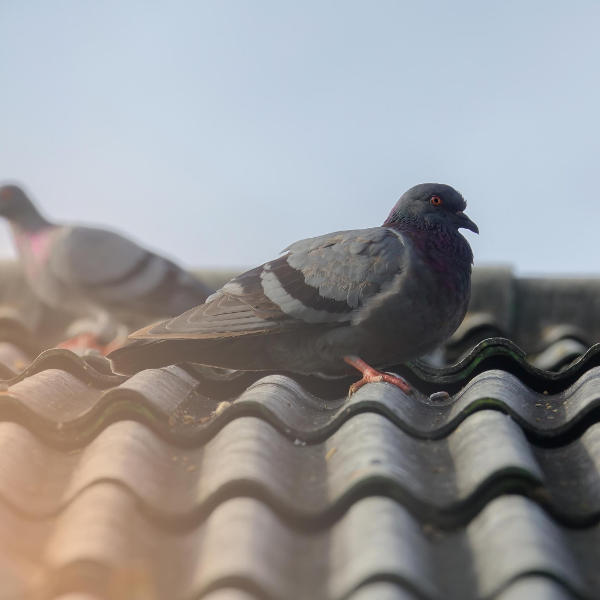
If you hear the sound of flapping wings overhead, don’t look up! Here comes one of Yuma’s most annoying pests. Pigeons settle in Yuma faster than a retiree can drive his RV out of Canada before the first snowfall!
You’ll notice pigeons huddling on your roof and front entrances; wherever they can find a slice of shade from the merciless desert sun.
Pigeons can poop up to 50 times a day. Their droppings are known to carry diseases such as psittacosis and tuberculosis. Hosing off pigeon droppings from your front door, driveway and patio furniture is a weekly chore. When left to rot, their droppings can erode your metal patio furniture. They are a constant nuisance here in Yuma.

You probably have fond memories of sitting on your back porch during summer evenings and listening to the sound of crickets chirping. The good memories can turn into a nightmare when crickets find their way into your home.
Crickets hop into homes at night when outdoor temperatures drop. Male crickets rub their wings together and make chirping sounds to attract female crickets and repel other males. This noise can keep you up all night.
And it's not just noise you'll have to deal with. Crickets can destroy house plants by feeding on them. Crickets will also chew on wood, fabrics, and even paper.
Since crickets can live for several months, it’s best to get rid of them right away to restore peace in your home.
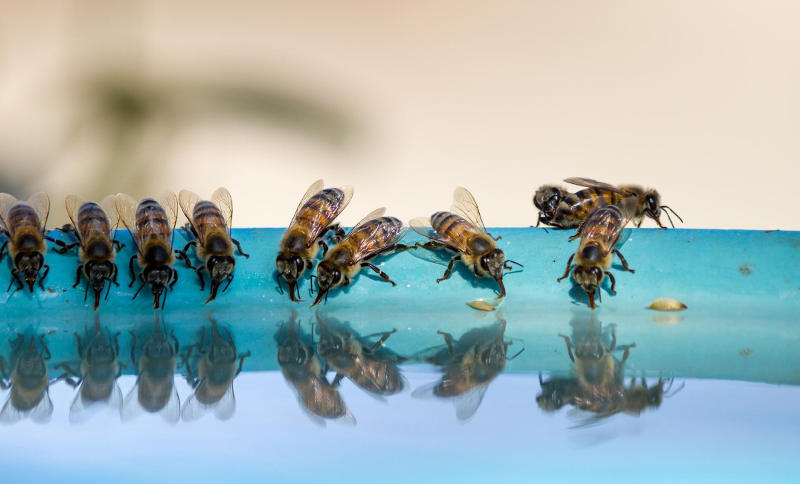
You’ll find that agriculture is a driving economic force throughout Yuma County. Where you find plants and flowers, you’ll find bees. While these insects are great pollinators, they also deliver painful stings to unwary backyard barbecue enthusiasts.
If you see them around your property, they are probably looking for water. You’ll often find them buzzing around pools and air condition condensation drains.
Bee issues get serious when they build their hives close to your home, deck, or detached garage. Normally honey bees avoid stinging you. Once they sting, they die so they are inclined not to sting you in favor of living. That said, if you threaten their hive they will defend it with their lives.
Spiders are among the most common pests in Yuma. While people tolerate them because of their ability to snare flies, others realize the dangers that spiders present. Spiders have no problem invading your home, garage or garden shed.
Certain spiders have venomous bites that can cause serious allergic reactions in sensitive people. Experts warn people to wear long pants, long-sleeved shirts, and gloves when going into areas of their property that might house spiders such as the Arizona brown spider or black widow spider.
You may not notice an increase in spider webs around your yard, patio or garage until your landscaper or pool maintenance man warn you they’ve found spider eggs on your property. Another easy way to tell is when your pets have small bumps on their heads, indicating spider bites. You’ll need pest control treatment almost certainly if spider eggs are found.

You might find trails of red ants in and around your house the day you move in. Ants are excellent examples of industrious workers. Even if you don’t have them in your own home, you can expect to see red ants somewhere in your neighborhood. They are everywhere in Yuma.
Their single-mindedness to carry away the crumbs that surround your toaster oven leaves your kitchen counters, stovetop, and table vulnerable to dangerous organisms such as E. coli and salmonella.
Ants also bite. When small children or other sensitive persons are bitten by ants, they can develop painful lesions that require antiseptics to prevent infections. Don't let ants have free reign over your home. Call ant extermination experts at Hitman Pest of Yuma
Okay, okay. That’s not true. There are no killer flies in Yuma. But they act like it! Unlike anywhere else in the US, the house flies here in Yuma dive-bomb straight into your face! They don’t bite or sting, but it is super annoying when they savagely zoom into your ears and eyes!
Flies are the most annoying and prolific pests in Yuma. When we poll new residents for their first impressions of Yuma, almost all of them say that the flies here are the worst!
No matter how many fly traps you set around your house, you will inevitably have roommates of flies in your house. It’s just your new reality when you move to Yuma.
But these pesky critters aren't just annoying, they can carry harmful diseases and parasites. You'll often see flies around trash and waste who will then land on surfaces in your home. Don't waste any time putting up with insects.
High doses of sunshine, mild winters, and ample recreation activities make this a culturally rich desert city. Its slow pace and charming family-owned businesses make it a highly desirable place to retire or raise a family.
Don’t let your quality of life take a hit because of common pest problems. Take out a contract on those pest!
Hitman Pest of Yuma specializes in safely and effectively eradicating insects and wildlife from homes in Yuma County.
Our experienced, responsive team of exterminators are standing by to answer your questions about pest control in Yuma. Call us today for a free quote on service.
If you believe your grade-school science teacher, you probably think spiders are wonderful at catching other pests like flies and mosquitoes in their webs. It turns out your teacher only told you half the story about spiders. The bite of certain spider varieties such as the recluse spider can cause severe damage to skin, nerves, and blood vessels. So if you're home has been invaded by spiders, act fast and get someone to your home for pest control ASAP!
Here’s what you need to know about recluse spiders, where they live, and how to find them!
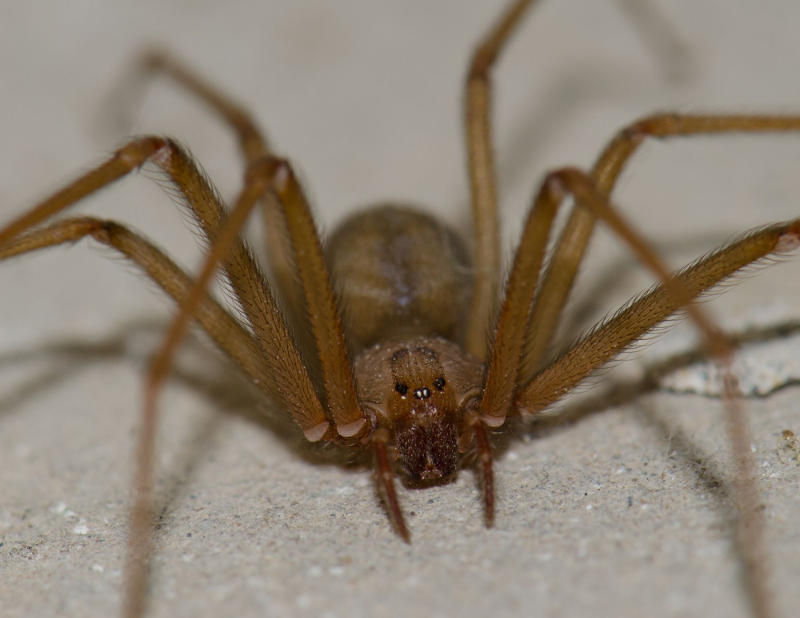
The recluse is a shy spider with an audacious bite. As its name implies, this spider hides to protect itself and only bites when it’s really desperate. While the most commonly know recluse is the Brown Recluse, the recluse spider can also be tan, black, or gray in color. In Yuma, we're a likely to fine the Arizona Recluse or Desert Recluse
Reproduction is always a key consideration for those interested in spider control. The female recluse spider produces several sacs of eggs between the months of May and July. Each sac has about 50 eggs, and take one month to hatch. You can expect a recluse spider to have a lifespan of 12 to 24 months.
If you think that Yuma’s stark, desert environment is enough to get rid of spiders, think again. The recluse spider is known for its resilience. It can survive for several months without food or water.
While there are several places for the recluse spider to lounge on your property, it arguably likes being outdoors. You’ll find this spider hiding under fallen tree branches, under rocks, and in piles of decaying leaves. The recluse also likes to hang out around firewood piles. It loves to hide in dark, cluttered places during the day and hunt prey at night. One of our customers even found a cluster of recluse eggs in her pool’s filter!
If a recluse spider makes its way into your home, you have a real problem and need to call professional spider control experts. It usually means that there are others and that a colony of dangerous critters has formed in your house. When indoors, the recluse spider likes to hide in dark basements, garages, and storage closets.
Practical spider control methods can help you to avoid hazards related to the recluse spider. Eliminate clutter in and around your home. By raking leaves and cleaning workbenches and gardening equipment, you’ll eliminate the spiders’ webs and the places where they like to hide. Make sure to wear gloves when handling firewood. If you suspect a spider infestation in your home, always shake out your clothes and shoes before getting dressed.
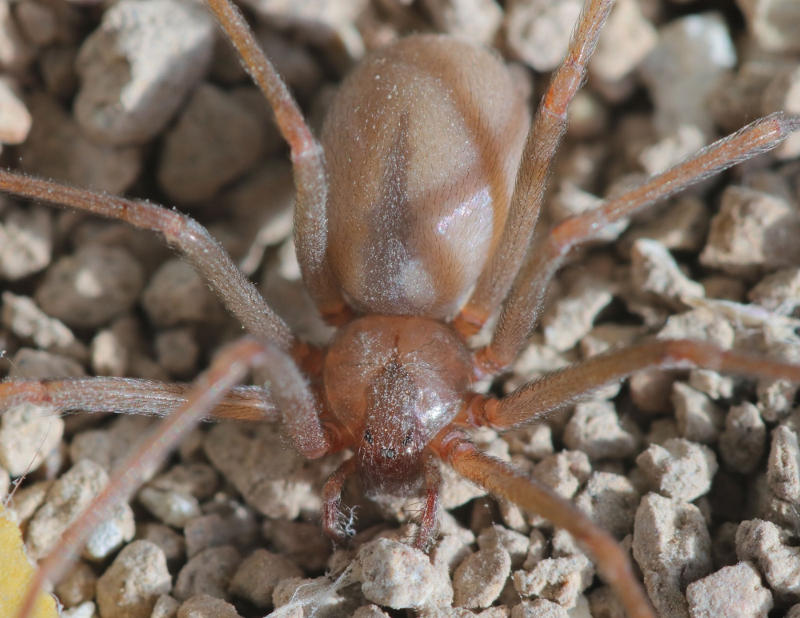
While the recluse spider likes to hide, it can hold its own when threatened. Its venomous bite can cause necrosis, which is cell death. The recluse spider rarely bites people or pets. When a recluse spider bites a person, it’s usually because the spider is hiding in clothing items and is accidentally caught near a person’s skin.
A few hours after a recluse spider bite, the person’s skin is usually red and swollen near the bite area. The bite area can blister and form an ulcer. Eventually, the ulcer turns a dark color that indicates that the skin tissue is dying. Everybody’s physical make up is different, so you could have a less severe reaction to a recluse spider bite than your neighbor down the street.
If you believe that you’ve been bitten by a recluse spider, the National Institute of Health recommends that you wash the affected area and apply ice to it in 10-minute intervals. It advises you to go immediately to the emergency room and bring the spider with you for identification purposes.
One of the most distinguishing features of the recluse spider is its eyes. It has three pairs of eyes that form a semi-circle on the front of its body. Most other spiders have eight eyes.
Don’t want to get close enough to make eye contact with a potential recluse spider? Check out its back instead. The recluse spider is often called the "fiddle-back spider" because it has a violin-shaped marking on its back. Since the rest of the spider’s body is uniform in color, this marking really stands out.
According to experts at the University of Arizona’s Cooperative Extension Program, the notorious brown recluse spiders haven’t set up house in our state. However, Arizona is home to a couple of their dangerous cousins, Arizona recluse and desert recluse spiders. Since these recluse spiders also inflict tissue-damaging bites, there’s no need to become attached to them. When you need to get rid of spiders in Yuma, call the Hitman.
Hitman Pest of Yuma specializes in taking out all types of pests that include the recluse spiders that plague Arizona homeowners.